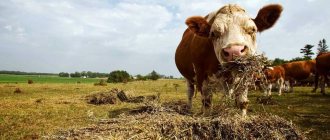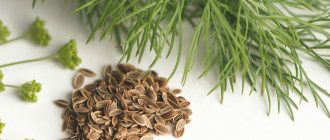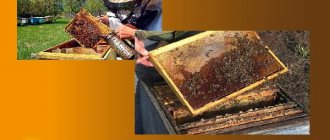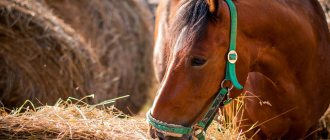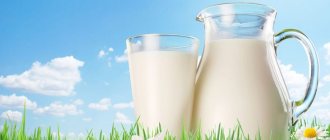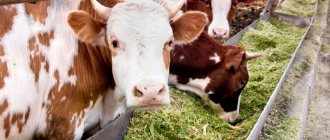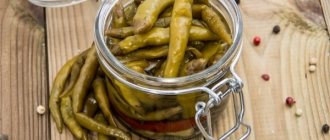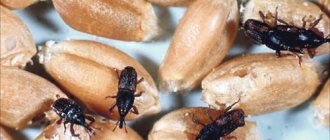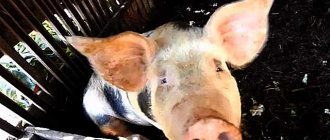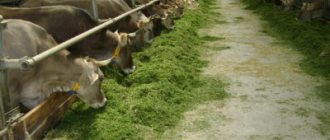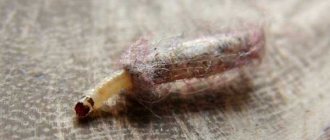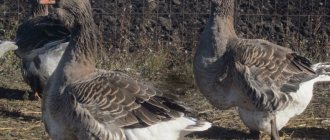Goat farming has become a popular form of livestock farming. This is explained by the unpretentiousness of small horned livestock and not being particularly picky about food. In summer, individuals feed mainly on green grass. However, before the onset of cold weather, farmers, especially beginners, often face the question of what to feed their pet in the pen and how much hay the goat needs to prepare for the winter. For many this becomes a real problem. However, there are no difficulties here. You just need to know what the goat’s winter diet should consist of and follow the rules for choosing products and substances included in the pet’s daily menu, as well as the principles of making hay.
How much hay does a goat need?
Goat farming is a popular livestock industry. These pets become an indispensable part of the household in areas with a temperate climate if simple rules of care and feeding are followed.
Daily norm
To produce nutritious and fatty milk and ensure good animal health per day, goats need:
- 4 kilograms – milking individual;
- 6 kilograms - goat;
- 2 kilograms for a kid.
The volume of hay may be diluted with chew additives, vitamins or grains.
For the winter
For adequate nutrition of one individual, from 400 to 600 kilograms of hay preparations for the winter period are required. The amount of reserves depends on the weight of the animal, sex and duration of the cold period.
Important! On average, one goat eats 120 kilograms of hay per month (4 kilograms for 30 days). However, when calculating the required supply, it is best to add an extra 100 kilograms on top.
Annual norm
Good animal care and a balanced diet for domestic goats are fully paid for by the milk they receive. Proper nutrition protects animals from the risks of digestive disorders and promotes the harmonious development of young animals. During the summer months, goats graze and replenish their need for grass while walking. During this period, diet enrichment is aimed at juicy additives, vegetables and fruits. The total volume of food consumed per goat is, on average, about 1.5 tons.
Important! It has been noticed that when vitamin E is added to goat food, the resulting milk becomes softer. Bitterness and sour taste disappear.
See also
Instructions for use of calcium borogluconate for goats and contraindicationsRead
Keeping livestock in winter
In winter, food intake takes place in 2 stages. The first involves feeding with roughage, the second with vitamin mixtures, concentrated substances and vegetables.
Basic content rules:
- balanced diet for feeding goats in winter;
- frequent walks outdoors;
- being in a clean and comfortable room with special equipment.
Hay is the main type of food for goats in winter. It should always be in the diet. All food should have a pleasant smell. Mold is not acceptable.
It is important to take care of the absence of drafts, insulation of walls, floors and ceilings, and the presence of bedding. It is necessary to maintain order in the room, optimal temperature conditions and natural lighting.
Animals must have access to warm or hot water. It’s good if it is possible to install heated drinking bowls.
How to make hay yourself
If a livestock breeder decides to mow and dry hay for winter harvesting on his own, you should pay attention to several rules:
- Wildflowers need to be mowed before flowering begins;
- cereal crops are mowed during heading;
- legumes - at the beginning of bud opening;
- Mow should be done on warm days after the dew has dried.
Experienced livestock breeders prefer to store hay on their own, as this process contributes to a careful selection of the components of the animal’s diet during the winter.
Types of dried herbs
In summer, animals themselves choose grass for food. In winter, humans make this choice for the animals. The cows' mood, appetite, quantity and quality of milk depend on the right choice. For these reasons, you need to be careful when preparing or purchasing hay.
It is better to harvest dried grass during the flowering period of plants. During bud formation, plants accumulate twice as much valuable nutrients. It is useful to mow legumes for hay, because they contain a lot of calcium and protein. They have milk-producing properties and are very filling. But animals should not be fed exclusively legumes; the digestive system may be damaged.
The presence of the following legumes in dried grass is beneficial:
- soy;
- clover;
- chickpeas;
- alfalfa;
- peas;
- sainfoin.
Dried grass from cereal crops is of high quality. They are easy to prepare; if overfed, they do not cause poisoning in farm animals. But grains have low nutritional value compared to legumes. It is necessary to add other components to such hay to enrich the feed.
Cereals are required in the diet of animals. It is useful to add the following plants:
- timothy grass;
- wheatgrass;
- barley;
- wheatgrass;
- sweet clover;
- bonfire;
- wheat;
- oats.
Hay from forbs is useful. Large farms engage in special planting of grass for fodder. This approach helps to make the feed balanced. On small farms, meadow grass is cut. It is advisable to understand herbs so that poisonous plants and bitter grass do not get caught in the hay. This will reduce appetite and lead to loss of milk production and weight.
By growing cereals and legumes together, their nutritional value can be increased and the composition of hay can be improved. This will significantly reduce the susceptibility of legumes to fungal infection, which will reduce hay spoilage.
Storage rules
Like other organic products, if storage conditions are incorrect, hay can rot, rot and ultimately become unsuitable for goats.
Expert opinion
Zarechny Maxim Valerievich
Agronomist with 12 years of experience. Our best country expert.
Ask a Question
In winter, food supplies are especially important due to the difficulty of renewing spoiled food.
The basic rules for storing hay include:
- Dry thoroughly.
- Tedding compacted areas during drying.
- Prevents drying out.
- The presence of a spacious hayloft.
- Protection from moisture (rain, snow, damp soil).
- Full natural ventilation.
- Elevation above the ground (wooden logs).
Compliance with these simple rules will ensure the safety of harvesting until the next season.
Features of feeding cows in winter
The most technologically advanced and economical type of livestock feeding is hay and silage. A wide range of feeds in winter allows you to normalize digestion processes and obtain high milk yields of good quality.
Farms often use the silage-concentrate type of feeding of dairy cows, which is the most dangerous due to metabolic disorders.
Feeding corn silage together with hay or straw helps stabilize the acidity in the rumen at a pH level of 6 - 7. To reduce the acidity of the silage and prevent rumen acidosis, it is necessary to use ammonia water, feed chalk, and soda.
Corn silage proteins quickly break down into ammonia in the rumen, and protein loss is possible due to the rapid increase in ammonia concentration in the rumen fluid. This occurs as a result of a deficiency of sugars to ensure synthetic processes in the rumen. Therefore, it is necessary to feed silage in combination with beets, molasses, and concentrates. It should be taken into account that the daily intake of carbohydrate feed (pulp, mixed feed, dirt, beets) must be fed in fractional portions in 4 - 6 doses.
At one time, the cow must be given 3 - 5 kg of beets, 1 - 1.5 kg of raw pulp, 1 - 1.5 kg of concentrated feed in order to prevent acidosis in the rumen. It is advisable to first distribute silage and one portion of concentrated feed and beets, and after milking - the next portion of beets and concentrates, that is, first feed less tasty and attractive to cows, and then more energy-rich and well-eaten ones.
Feeding concentrates is important, especially for cows during the new calving period, when their daily intake can be 12 kg (daily milk yield 30 kg and above). Formulated feed must be fed in doses 6 times a day and no more than 2 kg at a time
To avoid reducing the fat content of milk, it is necessary to add sodium acetate or diacetate to the concentrated feed in an amount of 100 - 150 g per head per day.
Compound feed is given in dry form to increase saliva secretion and neutralize excess acidity during fermentation in the rumen. If formula feed is given in soaked form, then it is advisable to distribute hay, pellets or briquettes after it.
In order to normalize digestion processes in the forestomach, the use of feed mixtures is promising. Their positive effect on the palatability of feed and the digestibility of nutrients has been established.
Depending on the composition of feed mixtures, they are divided into complete and bulk. Complete feed mixtures contain the entire range of feeds in the required quantities (hay, silage, haylage, beets, molasses, concentrated feed, pulp). Bulk feed mixtures are prepared from hay, haylage, silage, beets, molasses, pulp, etc. They do not contain concentrated feed.
When feeding feed mixtures, at least two of their compositions should be used: for cows in the first stage of lactation, and for cows in the second and last third of lactation.
A complete feed mixture for highly productive cows should contain 10.5 - 11 MJ of metabolizable energy, 16 - 17% crude protein, 18% crude fiber per 1 kg of dry matter. It must have a physical structure acceptable to ruminants, containing 45 - 55% dry matter. To prepare 1 ton of such feed mixture, 60 kg of alfalfa hay, 260 kg of alfalfa haylage, 340 kg of corn silage, 40 kg of feed molasses, and 300 kg of mixed feed are required.
To feed cows, only freshly prepared feed mixtures should be used, the shelf life of which does not exceed 2 - 3 hours.
When feeding cows in winter with low-quality, roughage feed (hay, haylage, silage, straw), they are crushed, steamed, flavored with molasses, beets, concentrated feed, salted, and yeasted.
V. Golovan, Doctor of Agriculture Sciences, N. Podvorok, Candidate of Agricultural Sciences Sciences, North Caucasus Research Institute of Animal Husbandry
Alternative winter feeds and diet supplements
The nutrition of goats affects not only the general condition of the animal, but also the quality and taste of the milk obtained. In order for the animals to receive the full range of vitamins and microelements, and also to strengthen the chewing apparatus, the goat breeder needs to prepare:
- young branches of trees and shrubs (raspberry, apple, willow, pear, beech, maple, birch, oak, linden);
- willow bark;
- fir branches;
- dry leaves;
- grain crops (oats, barley, corn, wheat);
- vegetables, root vegetables (fodder beets, carrots, fresh potatoes, pumpkin, zucchini) - no more than 3 kilograms (for an animal weighing 50 kilograms) per day;
- field herbs (chamomile);
- straw (barley, oat);
- vitamin supplements (check with your veterinarian).
See also
How long are goats raised for meat, age for castration of kidsRead
Important! Despite the usefulness of grain crops, an excess of this product can lead to a rapid increase in the weight of the animal and a decrease in milk production.
Important Tips
Goats can produce milk by eating straw alone, but this approach is unacceptable. It is important to think about productive longevity and high milk yield. Therefore, monofeeding is not encouraged on the farm.
There are other important tips to consider before feeding your goat in winter:
- On average, the daily volume of feed is 2 kg of dry food and products, 2 kg of succulent food and 0.5 kg of concentrate.
- Accustoming a goat to an appropriate diet should be gradual. In the mornings at the end of spring, the animal begins to be fed hay, giving less greenery.
- If the goat gains a lot of weight and becomes less active, you need to reconsider the structure of the diet. Perhaps the artiodactyl is overfed with concentrates. It is worth reducing the proportion of grain by 100-200 g.
- Excess concentrates can cause urolithiasis, so it is important to choose feeds that are balanced in composition. At the first signs of the disease, substances rich in phosphorus are removed from the diet, and the amount of vitamins, zinc, copper, cobalt, and manganese is increased.
The main mistake in feeding a goat in winter is limiting food and sudden changes in diet. It is important to ensure a balanced diet and provide the animal with all the necessary vitamins and minerals.
Amount harvested per head in winter
First of all, to correctly calculate a cow’s diet, you need to take into account several factors. First of all, the region in which the farm is located. Depending on the climate, the grazing period of an animal may increase or decrease. For example, in Siberia, harvested hay will be needed in October. In places with a milder climate - a little later. You might also find it useful to learn about how to get a cow stomach.
On average, 100 kilograms of animal body weight requires 2-4 kg of hay.The grazing season can also begin in different ways. In some areas it begins already in mid-April, and in others - towards the end of May. The longer the cow is kept in stalls, the more hay the owner stores.
An important factor is the weight of the cow. The more a cow weighs, the more hay she needs.
It may also be useful for you to learn about what it looks like and how the Yaroslavl breed of cows is raised.
The physiological state of the animal must also be taken into account. A pregnant cow, weakened after childbirth or illness, should receive more easily digestible feed. Accordingly, slightly less hay is consumed.
The amount of food given depends on the purpose for which the animal is kept. If a bull is being raised for meat, hay should be the basis of its diet. For a cow during active lactation, hay makes up 25-30% of the total feed given.
It will be much more difficult for a cow owner to find a potential buyer for a specific hay product. Moreover, you can easily scare away existing customers. And for a private economy, such a loss can become a significant financial gap. This material will tell you how much milk a cow gives per day.
The quality of the finished product will directly depend on the quality of the hay. Bitter herbs in the feed will certainly worsen the taste and smell of milk.
Food containing bitter herbs is reluctantly eaten by animals. As a result, the weight of the animal decreases. This is unacceptable for meat farming.
But what does the Kostroma breed of cows look like and how large is its milk yield and how to achieve large milk yields.
Cow's daily diet in tables
In order for the cow to receive the maximum amount of nutrients and produce a lot of milk, feed must be distributed correctly throughout the day. Food products are provided three times a day. The table below shows an example of a diet with the amount of feed required (Figure 8):
- In the morning and at noon they provide grain and succulent feed;
- Roughage should be included in every meal;
- It is necessary to adhere to a clear scheme for dispensing feed for better consumption: first concentrates, then juicy and finally coarse;
- After each feeding, animals need to be given a drink.
Feed must be prepared before distribution. The grain is crushed or ground into flour, and their concentrates are prepared into a thick mash or given out dry. To improve the palatability of concentrated feed, a little table salt is added to it.
Figure 8. Table of approximate rations for cattle
All root vegetables, including potatoes, must be thoroughly cleared of soil and washed before feeding, after which they can be fed raw. Mineral supplements and table salt are given in the form of licks, but if they are unavailable, you can simply add them to concentrated feed. From the video you will learn how to properly prepare feed for feeding.
Nutritious and balanced feed is the key to high milk production. To develop feeding rations, special standards are used based on the nutritional needs of cows.
Every day, each individual must consume a certain amount of proteins, amino acids, fiber, starch, fats, sugar, vitamins, trace elements and minerals.
But since it is quite problematic to accurately determine the intake of certain elements, nutrition algorithms for cattle are developed taking into account only basic indicators.
In this article you will find tables with approximate rations for cows for independently creating a livestock nutrition schedule.
| Feed | Daily allowance, kg | Dry matter, kg | Feed units, kg | Digestible protein, g | Calcium, g | Phosphorus, g | Carotene, mg |
| Meadow hay | 12,0 | 9,6 | 5,5 | 588,0 | 84,0 | 24,0 | 180,0 |
| Turnips | 15,0 | 1,2 | 1,3 | 105,0 | 5,0 | 5,0 | — |
| Potato | 5,0 | 1,0 | 1,5 | 60,0 | 1,0 | 3,5 | — |
| Compound feed | 4,5 | 4,0 | 4,5 | 495,0 | 4,5 | 13,5 | — |
| Carrot | 6,0 | 0,8 | 0,8 | 48,0 | — | — | 360,0 |
| Table salt | 0,07 | — | — | — | — | — | — |
| Total in diet | 42,57 | 16,6 | 13,6 | 1296,0 | 94,5 | 46,0 | 540,0 |
| Stern | Quantity, kg | They contain | ||||
| Feed units | Protein, g | Calcium, g | Phosphorus, g | Carotene, mg | ||
| Silage | 15,0 | 3,0 | 210,0 | 23,0 | 83,0 | 225,0 |
| Meadow hay | 6,0 | 2,52 | 288,0 | 36,0 | 13,0 | 90,0 |
| Spring straw | 2,0 | 0,62 | 28 | 8 | 2 | 3 |
| Sunflower cake | 0,7 | 0,77 | 277,0 | 3,0 | 7,0 | 1,0 |
| Wheat bran | 1,5 | 0,1 | 195,0 | 2,0 | 15,0 | 6,0 |
| Feed precipitate | 0,1 | — | — | 26,0 | 17,0 | — |
| Pine flour | 1,0 | — | — | — | — | 80,0 |
| Total | 8,01 | 998,0 | 98,0 | 62,0 | 405,0 | |
| Required by standard | 8,00 | 960,0 | 90,0 | 60,0 | 400,0 |
| Element | Cash cows | Pregnant cows | |
| During the second half of pregnancy | Deadwood | ||
| Calcium, g | 4,0–6,0 | 5,0 | 9,0–9,5 |
| Phosphorus, g | 3,0–5,5 | 4,2 | 5,0–5,5 |
| Magnesium, g | 1,2–2,0 | 1,2 | 1,1 |
| Sulfur, g | 2,0–3,0 | 2,0 | 2,0 |
| Potassium, g | 8,0–14,0 | 8,0 | 7,5–7,6 |
| Sodium, g | 1,5-2,0 | 1,5 | 1,5 |
| Copper, mg | 10,0 | 10,0 | 9,4–9,5 |
| Zinc, mg | 30,0 | 30,0 | 28,3–28,5 |
| Manganese, mg | 60,0 | 60,0 | 57,0 |
| Cobalt, mg | 0,5 | 0,5 | 0,5 |
| Iron, mg | 70,0 | 70, | 66,0 |
| Iodine, mcg | 100,0 | 100,0 | 90,0 |
| Molybdenum, mg | 1,2 | 1,2 | 1,1 |
All examples given in the tables are illustrative. The exact amount of food and vitamins depends on the general condition of the animal at one time or another. Remember that the quality of feed for the cow must be high. Spoiled or stale products can affect the health of livestock and the quality of milk.
The nutrition of dairy and pregnant cows should be balanced. Productivity indicators, the health of the cow and its offspring depend on this.
